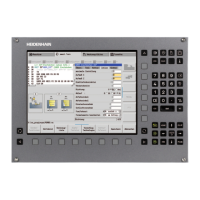864 HEIDENHAIN Technical Manual MANUALplus 620
6.16.13 Active damping of low-frequency oscillations
The active damping of low-frequency oscillations is suitable for damping noise
oscillations of approx. 10 to 30 Hz. The damping factor is set in
MP_compActDampFact, and the damping time constant in
MP_compActDampTime. It can be calculated according to the following
formula:
k: Factor from 0.8 to 1.0
f: Frequency to be damped (approx. 10 Hz < f < 30 Hz)
Activating the active damping:
Ascertain the deepest resonant frequency (e.g. with the frequency diagram
in TNCopt when adjusting the IPC and k
V
factor).
Set MP_compActDampFact = 1.5.
Calculate the damping time constant according to the above formula with k
= 0.9, and enter this value in MP_compActDampTime.
Record I (n int) or s diff with the integrated oscilloscope, and move the
axis with the axis-direction buttons.
Vary the value of k up and down somewhat (between 0.8 and 1.0), calculate
MP_compActDampTime and compare the oscilloscope recordings in order
to find the correct value for MP_compActDampTime (the value with the
lowest amplitude).
Vary MP_compActDampFact, and compare with the recordings in the
frequency diagram in TNCopt for the adjustment of the IPC and k
V
factor.
Select the value for MP_compActDampFact by evaluating the advantages
and disadvantages of the active damping.
This function is not available for a CC 61xx or UEC 11x!
Settings in the configuration editor MP number
Axes
ParameterSets
[Key name of the parameter set]
CfgControllerComp
compActDampFact
compActDampTime
401409
401410
MP_comActDampTime
k
2 π f⋅⋅
-----------------=
The active damping should only be used if improvements actually occur,
since the damping could also lead to lower and higher frequencies being
fortified.

